
Procellariiformes is an order of seabirds that comprises four families: the albatrosses, the petrels and shearwaters, and two families of storm petrels. Formerly called Tubinares and still called tubenoses in English, procellariiforms are often referred to collectively as the petrels, a term that has been applied to all members of the order, or more commonly all the families except the albatrosses. They are almost exclusively pelagic, and have a cosmopolitan distribution across the world's oceans, with the highest diversity being around New Zealand.

Shearwaters are medium-sized long-winged seabirds in the petrel family Procellariidae. They have a global marine distribution, but are most common in temperate and cold waters, and are pelagic outside the breeding season.

The family Procellariidae is a group of seabirds that comprises the fulmarine petrels, the gadfly petrels, the diving petrels, the prions, and the shearwaters. This family is part of the bird order Procellariiformes, which also includes the albatrosses and the storm petrels.

The great shearwater is a large shearwater in the seabird family Procellariidae. It breeds colonially on rocky islands in the south Atlantic. Outside the breeding season it ranges widely in the Atlantic.

Cory's shearwater is a large shearwater in the seabird family Procellariidae. It breeds colonially of rocky islands in the eastern Atlantic. Outside the breeding season it ranges widely in the Atlantic. It was formerly considered to be conspecific with Scopoli's shearwater.

Zino's petrel or the freira, is a species of small seabird in the gadfly petrel genus, endemic to the island of Madeira. This long-winged petrel has a grey back and wings, with a dark "W" marking across the wings, and a grey upper tail. The undersides of the wings are blackish apart from a triangle of white at the front edge near the body, and the belly is white with grey flanks. It is very similar in appearance to the slightly larger Fea's petrel, and separating these two Macaronesian species at sea is very challenging. It was formerly considered to be a subspecies of the soft-plumaged petrel, P. mollis, but they are not closely related, and Zino's was raised to the status of a species because of differences in morphology, calls, breeding behaviour and mitochondrial DNA. It is one of Europe's most endangered seabirds, with breeding areas restricted to a few ledges high in the central mountains of Madeira.

Calonectris is a genus of seabirds. The genus name comes from Ancient Greek kalos, "good" and nectris, "swimmer".

The wedge-tailed shearwater is a medium-large shearwater in the seabird family Procellariidae. It is one of the shearwater species that is sometimes referred to as a muttonbird, like the sooty shearwater of New Zealand and the short-tailed shearwater of Australia. It is found throughout the tropical Pacific and Indian Oceans, roughly between latitudes 35°N and 35°S. It breeds on the islands off Japan, on the Islas Revillagigedo, the Hawaiian Islands, the Seychelles, the Northern Mariana Islands, and off Eastern and Western Australia.

Ilhéu Raso is an uninhabited 5.76 square kilometres volcanic island in the Barlavento archipelago of Cape Verde. It is flanked by the smaller Branco islet to the west and by São Nicolau island on its eastern side. The distance from the island of São Nicolau is 15 kilometres. Together with Santa Luzia and Ilhéu Branco, Ilhéu Raso is on the tentative list of UNESCO's World Heritage Sites. Since 1990, the islet is part of the protected area Reserva Natural Integral de Santa Luzia.

Ilhéu Branco is an uninhabited 278-hectare (690-acre) islet in the Barlavento group of the Cape Verde archipelago off the coast of north-west Africa in the Atlantic Ocean. Ilhéu Branco is flanked by the islands of Santa Luzia to the north-west and Ilhéu Raso to the south-east. Since 1990, the islet is part of the protected area Reserva Natural Integral de Santa Luzia. Together with Santa Luzia and Ilhéu Raso, Ilhéu Branco is on the tentative list of UNESCO's World Heritage Sites.

The Cape Verde Islands dry forests is a tropical and subtropical dry broadleaf forests ecoregion in the Cape Verde Islands, which constitute the country of Cabo Verde. The islands lie off the western coast of Africa.

Muttonbirding is the seasonal harvesting of the chicks of petrels, especially shearwater species, for food, oil and feathers by recreational or commercial hunters. Such hunting of petrels and other seabirds has occurred in various locations since prehistoric times, and there is evidence that many island populations have become extinct as a result. More recently ‘muttonbirding’ usually refers to the regulated and sustainable harvesting of shearwaters in Australia and New Zealand. These include the short-tailed shearwater, also known as the yolla or Australian muttonbird, in Bass Strait, Tasmania, as well as the sooty shearwater, also known as the titi or New Zealand muttonbird, on several small islands known as the Muttonbird Islands, scattered around Stewart Island in the far south of New Zealand.

The wildlife of Cape Verde is found across its archipelago of ten islands and three islets, albeit in smaller numbers of species than mainland Africa. Each volcanic island within the archipelago is unique, and each of them have parks under their jurisdiction, by decree promulgated by the Cape Verde government. Located just off the west coast of Africa, the total land area of the island nation is 4,564 square kilometres (1,762 sq mi).
With the exception of bats, there are no truly endemic species of mammal on Cabo Verde; historically, the archipelago was only accessible to creatures with the ability to fly or swim, or to be brought by humans. The islands were first explored in 1456, but not actually settled until 1462; humans brought their livestock with them, including donkeys, pigs, cattle and goats—many of the latter are now so wild, they resemble mainland ibex, and are considered endemic “by default”.
In the centuries since settlement began, more mainland species would make their way with waves of settlers. There are no snakes present on the archipelago, which has allowed for the proliferation of many other species of other herpetiles, such as geckos, frogs and lizards. The main predators of these reptiles and amphibians would be the various birds of prey and raptors present, including the Egyptian vulture, Eurasian buzzard, kestrel, osprey, peregrine falcon, and the rare Cape Verde kite. This kite species is currently threatened by extinction but may yet be observed on Boa Vista and Maio.

The Juan Fernández petrel is a species of seabird in the family Procellariidae. It nests on a single island off the coast of Chile, in the Juan Fernández Archipelago. It was previously classified as a subspecies of the white-necked petrel, which is found in tropical waters of the Pacific and Indian Oceans.

The fluttering shearwater is a species of seabird in the family Procellariidae. It is endemic to New Zealand and migrates to Australia and the Solomon Islands. Its natural habitats are open seas and rocky shores. It has been known as Forster's shearwater in the past.

The Raso lark is a small passerine bird with a highly restricted range, being found only on Raso islet in the Cape Verde Islands. This critically endangered member of the family Alaudidae lives in very arid terrain, and is considered one of the least known birds in the Western Palaearctic region, due to its remoteness and the lack of much ornithological study on the archipelago as a whole.

The term seabird is used for many families of birds in several orders that spend the majority of their lives at sea. Seabirds make up some, if not all, of the families in the following orders: Procellariiformes, Sphenisciformes, Pelecaniformes, and Charadriiformes. Many seabirds remain at sea for several consecutive years at a time, without ever seeing land. Breeding is the central purpose for seabirds to visit land. The breeding period is usually extremely protracted in many seabirds and may last over a year in some of the larger albatrosses; this is in stark contrast with passerine birds. Seabirds nest in single or mixed-species colonies of varying densities, mainly on offshore islands devoid of terrestrial predators. However, seabirds exhibit many unusual breeding behaviors during all stages of the reproductive cycle that are not extensively reported outside of the primary scientific literature.

Seabirds include some of the most threatened taxa anywhere in the world. For example, of extant albatross species, 82% are listed as threatened, endangered, or critically endangered by the International Union for Conservation of Nature. The two leading threats to seabirds are accidental bycatch by commercial fishing operations and introduced mammals on their breeding islands. Mammals are typically brought to remote islands by humans either accidentally as stowaways on ships, or deliberately for hunting, ranching, or biological control of previously introduced species. Introduced mammals have a multitude of negative effects on seabirds including direct and indirect effects. Direct effects include predation and disruption of breeding activities, and indirect effects include habitat transformation due to overgrazing and major shifts in nutrient cycling due to a halting of nutrient subsidies from seabird excrement. There are other invasive species on islands that wreak havoc on native bird populations, but mammals are by far the most commonly introduced species to islands and the most detrimental to breeding seabirds. Despite efforts to remove introduced mammals from these remote islands, invasive mammals are still present on roughly 80% of islands worldwide.

Scopoli's shearwater is a seabird in the petrel family Procellariidae. It breeds on rocky islands and on steep coasts in the Mediterranean but outside the breeding season it forages in the Atlantic. It is brownish grey above with darker wings and mostly white below. The bill is pale yellow with a dark patch near the tip. The sexes are alike. It was formerly considered to be conspecific with Cory's shearwater.





















